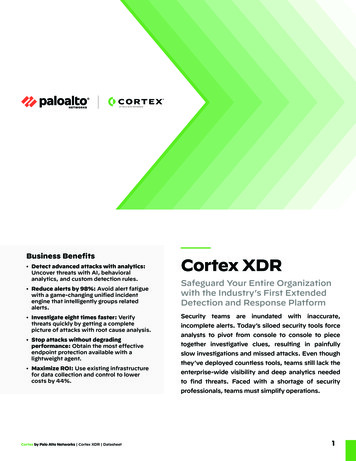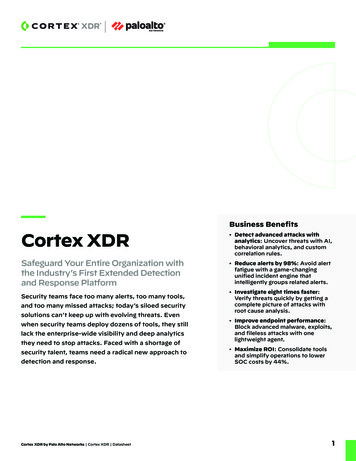
Transcription
The journey toXDR: practicalquestions to askEveryone in cybersecurity has heard the hype about extended detection and response (XDR),and many companies are interested in exploring this approach. But what should organizationsbe focused on as they research the growing number of solutions in the market?This white paper looks at the problems XDR addresses and discusses what security practitionersshould consider as they plan their journey. 2022 AT&T Intellectual Property. AT&T and Globe logo are registered trademarks and service marks of AT&T Intellectual Property and/or AT&T affiliated companies. All other marks are theproperty of their respective owners. The information contained herein is not an offer, commitment, representation or warranty by AT&T and is subject to change.WHITEPAPER
What is XDR?Extended detection and response, or XDR, is a holisticapproach to threat detection and response. It tacklesthe long-standing problem of siloed security by usingdifferent technologies to collect, correlate, and centralizenetwork, endpoint, and cloud telemetry from across theattack surface.For years, vendors have promised to address the needfor better visibility and better data sharing betweentools. With the move toward edge computing, and asbusinesses expand their digital footprints, security andoperational complexities increase. Hybrid architectures,the accelerating adoption of cloud computing, a vanishingnetwork perimeter, and a growing remote workforceare just some of the challenges organizations face whentrying to secure their IT environments.XDR extends the capabilities of the security informationand event management (SIEM) platform. It improveshow data is collected and correlated, and it gives thatdata context. With XDR, security practitioners getthe expanded visibility, advanced security analytics,continually updated threat intelligence, and automatedor orchestrated detection and response capabilitiesthey need to detect and respond to threats in real time.The XDR market is still emerging. Opinions vary on wherethe technology came from. But focusing on how XDRcame together is not as important as understanding theoutcomes it drives: more efficient IT operations and theability to identify, hunt, and remediate threats beforethey become security incidents.Two approachesSome vendors are entering the XDR market throughacquisition. They are driving toward single-vendor, ornative, solutions that offer a unified suite of security toolsfrom one vendor on a centralized management platform.Other vendors are choosing not to provide all componentsof their XDR solutions in house. Instead, they offer opensolutions with one central management console thatintegrates with multiple third-party security products.The year 2021 saw a large number of mergers andacquisitions driven by XDR. Notable deals includeCybereason’s July purchase of security analytics firmempow1; Logpoint’s acquisition of SecBI for its securityorchestration and automated response (SOAR) and XDRtechnologies2; and most recently, IBM’s announcement ofits plans to acquire endpoint security vendor ReaQta.31 Cybereason looks to help security teams with its XDR offering.Montenegro, Fernando. Oct. 27, 2021. 451 Research2 Another day, another XDR deal as LogPoint picks up SecBI for its analytics chops.Montenegro, Fernando. Sept. 2, 2021. 451 Research3 IBM reacts to XDR trend with portfolio announcements, pickup of ReaQta.Montenegro, Fernando. Nov. 3, 2021. 451 ResearchFocusing on how XDR cametogether is not as important asunderstanding its outcomes:more efficient operations andthe ability to identify, hunt, andremediate threats before theybecome security incidents.The need to evolve threat detection and responseTo understand why security practitioners should careabout XDR, it is important to understand the ongoingsecurity and operational challenges it helps them address.XDR is essentially a convergence of the capabilities ofdifferent security products. This convergence has beendriven by the need for: I ncreased telemetry from multiple sources and better,centralized visibility across an increasingly diverse anddistributed attack surface A dvanced analytics and machine learning to sortthrough the influx of data and provide context B etter use of automation and orchestration to enablefaster and more efficient threat detection and responseWhy XDR. . . and why now?Expand telemetry frommultiple sourcesGet increased visibility and information gatheringBoost threat intelligence and improvesecurity analyticsImprove time to detect and accuracy of detectionsAutomate andorchestrate workflowsAccelerate response speed and recovery time2
been up to the security practitioner to integrate thesetools in-house and then look across multiple dashboardsto understand when attacks are underway.XDR addresses this problem of siloed information bybringing together the different tools in a centralizedplatform for the end user. With XDR, the securitypractitioner can view events, investigate alarms, andrespond to threats from a single pane of glass. Andregardless of whether an XDR solution is the result ofa native or open integration, it is the vendor that takeson the responsibility of integrating the products andsystems—not the security practitioner.Threat intelligence provides more contextThrough advanced analytics and machine learningthat assesses and correlates the data, XDR can profilebehaviors to detect anomalies and predictively identifyadvanced threats, such as fileless malware, zero-dayattacks, and polymorphic attacks.XDR outcomesBetter visibility and more contextEffective threat detection and response requiresvisibility across the IT infrastructure because, ascybersecurity professionals like to say, “You can’tprotect what you can’t see.”Security practitioners need to be able to monitor theirentire attack surface—including across endpoints,network infrastructure, cloud workloads, applications,and more—to connect the dots and understand whenan attack is occurring in their environment. Withoutcontext, ongoing attacks can be missed. One phishingemail can lead to an infected endpoint. That can leadto an attacker moving laterally within the network toestablish persistence. Once the hacker has established abeachhead in your network, they can eventually delivera payload, whether that be encryption for ransomware,spying, data exfiltration, or another objective.XDR provides the security practitioner with visibility in theform of robust telemetry. This is gathered by differentsecurity tools from across the organization’s network,endpoints, servers, cloud workloads, and email. Thesecurity team can see all this data in one centralized view,so they can respond to threats quickly and effectively.Breaking down the siloesThe lack of communication between the many differentsecurity tools found in the typical security operationscenter (SOC) has long made the life of the securitypractitioner difficult. And while the capabilities found inXDR have been available in some of these tools, it hasXDR solutions use continuously updated threatintelligence and enhanced security analytics to increasethe accuracy of detections and improve time to detect.This includes mapping correlations and detections to theMITRE ATT&CK framework, which is a knowledge base ofadversary tactics and techniques. The threat intelligenceprovides additional context for the data and helps thesecurity practitioner triage responses.Workflows for automation and orchestrationWith so much data coming in to the SOC, manualprocesses for validation and correlation are a drainon resources and increase the chance of truethreats going undetected. While some analysis isautomated on the backend, security practitionersrequire better use of automation to help them sortand prioritize information.XDR simplifies day-to-day operations by allowing thesecurity practitioner to automate select workflows andprocesses. This includes investigating slow networkconnections, reviewing logs for unusual activity onmissing or destroyed devices, or identifying devices.With this automation, XDR speeds up investigations andhelps facilitate faster, more scalable incident response.For example, it provides automated root-cause analysis,so the security practitioner has the context and relevantinformation they need to take the appropriate responseactions. And with XDR, orchestrated response actionscan be activated by the security practitioner across alltools with just the click of a button.3
Planning and preparationFor the security leader seeking to lighten the load fortheir security teams and evolve their organization’scurrent threat detection and response capabilities, XDR’spromise is immensely appealing: greater efficiency insecurity operations and more agile security. But thereare already multiple offerings available in this emergingmarket, so where should the security leader start?Understand desired outcomesDecision-makers should begin by understanding thespecific objectives they seek for their organization.Based on those, they can evaluate how an XDR vendor’sbackground can help them meet these objectives.For example, if an organization is in a highly regulatedindustry, such as healthcare, manufacturing, or financialservices, it will have strict reporting and compliancerequirements. This organization would want an XDR vendorwith strong SIEM capabilities. Why? So the organization willhave the deep analytics and strong data log collection andlong-term data retention capabilities it requires.Network architecture and use cases will also driveconsiderations. For example, an organization that hasan IT estate focused heavily on Internet of Things (IoT)devices will not have the same visibility requirementsas the organization that has few IoT devices but manyendpoints. On the other hand, XDR vendors coming fromthe endpoint detection and response (EDR) space arelikely to be weaker on analytics but stronger at providingactionable response on the endpoint. Organizations withlarge numbers of endpoints that need to be monitored(and potentially restored in the event of an attack) willwant to partner with these vendors.Determining the best approachAs discussed earlier, vendors are implementing XDR inone of two ways: either by integrating security toolsfrom one vendor’s portfolio (commonly referred to as a“native” platform), or by utilizing third-party integrations(commonly referred to as an “open” platform).The organization that purchases a native XDR solution,in theory, will not have to implement and manageintegrations with technologies from other vendors.However, it will have to rip and replace what it has in itstechnology stack to lock in with a single preferred securityprovider—typically a costly and complex undertaking.And while the simplicity of this approach is attractive,it may preclude the organization from deploying moreinnovative solutions from other vendors as they emerge inthe market.Since vendor-agnostic, or open, solutions usethird-party integrations, customers can deploy themwithout having to replace tools they have alreadyinvested in. An important factor to consider with thesesolutions is whether the vendor has a large enoughecosystem for integration.Organizations that deploy tools from multiple vendorsare probably better off choosing an open platform orworking with a managed security service provider toleverage those investments.4
Key considerationsAs organizations assess who to partner with for theirXDR implementation, the following items are key: Current security stack IT and network infrastructure,including future plans Potential gaps in current detection andresponse capabilities Loyalty to current vendors End-of-life contracts Vendor roadmaps for XDRthe security practitioners want to make a change but arenot able to do so in the immediate future because they’relocked into a contract for several more years and insteadwill need to create a roadmap for that change.Loyalty to current providers will also be a factor. Doesthe organization intend to stay with its current SIEMplatform? Does its current endpoint security providercheck all the boxes? As organizations evaluate XDRsolutions, many will remain loyal to their existing SIEMand EDR vendors. A customer that is already using aneffective EDR solution is unlikely to switch to a productits security practitioners are not familiar with. However, ifvendors fail to deliver on their promised outcomes, thenorganizations will be more willing to make changes. Level of experience and expertise in the organizationVendor roadmaps are key Regulatory / reporting requirementsTake care to review vendor roadmaps for integration,including scale and scope. Ascertain whether vendors areplanning any integrations. If they are, understand how theyplan to achieve them. Whether a vendor approaches XDRthrough acquisition (i.e., as a native platform) or throughpartnerships (i.e., as an open platform), integration is key.Current controlsSecurity practitioners should evaluate the organization’scurrent security technologies and understand where theyhave gaps in their detection and response capabilities thatwill need to be addressed either through deployment ofadditional tools or by making changes to the current stack.Since the organization’s network is its attack surface, itwill be critical for security leaders not only to review theircurrent network roadmap but also to understand howtheir network and infrastructure will change over the nextthree to five years (for example with the rollout of an edgeinitiative). If the organization anticipates an increase in thenumber of endpoints on the network, then it should focusmore on vendors with strong EDR capabilities. Alternatively,if the organization prioritizes advanced analytics, broadvisibility into the network, and automated workflows, thenit should look to vendors with a strong SIEM component.If there is an incentive to reduce the number of vendors inthe organization’s technology stack, it will make sense forthe organization to look at native platforms and lock in witha particular vendor. However, if the organization has recentlyonboarded a vendor (for its endpoint security needs, asan example), it may not be feasible to switch to a differentvendor’s native platform. This is because ripping out thecurrent endpoint solution and implementing a new tool willlikely involve considerable time, training, and expense. Inthis case, the organization may be better off choosing anopen platform or working with a managed security serviceprovider so it does not have to rip and replace.If the organization has contracts that are reaching end-oflife, this would be a good time to evaluate making changes.Alternatively, the organization may be in a situation whereIf the vendor is partnering for its integrations,understand what that roadmap looks like in terms ofthe scale and scope of the integrations. Determine thevendor’s openness for integration with other vendors,not only for XDR capabilities, but also for other securitycontrols (for example, vulnerability management).For native XDR vendors, review acquisition roadmaps tounderstand which capabilities have truly been integrated.When vendors bring together multiple platforms throughacquisition, integrations are not always complete. Often,not all features are ported over, and some capabilities areprioritized over others.Even if a vendor has acquired other technologies and isnow positioning its platform as native, the platform willnot be truly native until the vendor’s engineers have fullyintegrated the new technology into it. And stitchingtogether different technologies is not a trivial task. Forexample, the SIEM provider that touts XDR capabilitiesshould be able to demonstrate that its platform has theadvanced analytical capabilities, machine learning, andworkflow capabilities to process correlations and alarmsfrom multiple sources.Further, these capabilities should be integrated to thepoint that it is a seamless experience for the SOC analyst.Can the analyst view data from multiple sources from asingle dashboard and act with the click of a button? Orwill they need to toggle between multiple dashboards toaccess different features?5
In-house capabilities vs. managed security servicesDetermine internal expertiseUnderstanding what expertise and experience theorganization has available in-house is also key. Whetherthe organization opts for an open platform or a nativeplatform, it will need skilled security professionals toresearch, deploy, and manage a complex solution that canbe challenging to roll out. Not only will staff need to knowhow to perform the integration during the deployment, butthey’ll also need to know how to fine-tune the platformand handle its day-to-day management.Understand the experience and expertise of theorganization’s current security team. Analyze whetherit has the knowledge and experience to deploy andmanage the platform.The organization may have a SOC in place to deploy andmanage its XDR, but if not, this capability will need to beoutsourced. While an in-house SOC gives an organizationgreater control and allows it to tailor security operationsto its specific needs, this may not be an option. Theannual costs of building and staffing a full-time SOC arenot trivial. According to a report from Forrester Research,SOCs can easily cost more than 1 million USD and take8–12 months to build.4If the organization does not have the requisite expertiseand experience in house, then it may find significantvalue in working with a managed security servicesprovider (MSSP) or managed detection and response(MDR) provider. These providers can help ask the rightquestions, perform an assessment to identify gaps incurrent detection and response capabilities, and helpthe organization work through how to roadmap from itsexisting technology stack to an XDR implementation.If the organization does have the in-house capabilities tohandle day-to-day management of the solution and doesnot plan to work with an MSSP or MDR provider, considerretaining the services of a consulting or professionalservices company or investing in a product supportservices retainer. This will ensure the SOC team hasaccess to on-call support when troubleshooting issues.If the organization does not have these capabilities inhouse, consider an MSSP or a consulting or professionalservices company. These providers offer different levels ofsupport, ranging from initial deployment and fine-tuningof the platform to day-to-day management, or acombination thereof.Evaluate vendorsPerform detailed research on the vendors and theircapabilities. Either conduct online research or set upinquiries with analysts from research firms.ConclusionThe need for organizations to defend their data has neverbeen higher, and that need will only intensify. According tothe 2022 Cybersecurity Almanac, global cybercrime costs areforecast to grow by 15% per year, hitting 10.5 trillion USDper year by 2025. This is up from 3 trillion USD in 2015.5XDR helps organizations fortify their networks byproviding better visibility into threats, more context,and automated workflows to facilitate faster and moreefficient incident response.However, while the benefits of this holistic approachto threat detection and response are clear, not allXDR solutions are alike. Before making any investmentdecisions, security practitioners should consider severalkey factors, such as organizational objectives and currenttechnology capabilities, to ensure they select thesolution that will best suit their needs.Next stepsAssess the current security stackReview the organization’s platforms and technologiesto identify where XDR capabilities currently exist andwhere there are gaps, both in feature sets and inintegrations within the organization’s current portfolio.Look at the current network roadmap, and alsounderstand how the organization’s network willchange over the next 3–5 years.4 Recruiting The Right Managed Security Service Providers, Forrester Research, Jan 2021, p. 105 Cybercrime Magazine: “2022 Cybersecurity Almanac: 100 Facts, Figures, PredictionsAnd Statistics.” 19 Jan 2022.WhyAT&TChoosing the right cybersecurity solutionscan be challenging. Evolving technologiesand threats continually redefine the digitallandscape. This makes your choice ofsecurity solutions key. We deliver the rightfit of insights and guidance, so you feelconfident in your ability to drive outcomesand defend your network. 2022 AT&T Intellectual Property. AT&T and Globe logo are registered trademarks and service marks of AT&T Intellectual Property and/or AT&T affiliated companies. All other marks are theproperty of their respective owners. The information contained herein is not an offer, commitment, representation or warranty by AT&T and is subject to change. 437101-0303226
Through advanced analytics and machine learning that assesses and correlates the data, XDR can profile behaviors to detect anomalies and predictively identify advanced threats, such as fileless malware, zero-day attacks, and polymorphic attacks. XDR solutions use continuously updated threat intelligence and enhanced security analytics to increase










